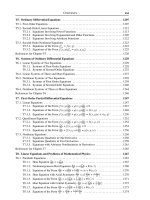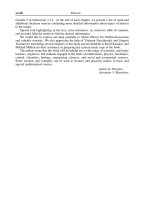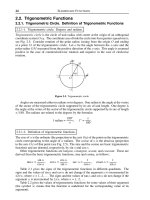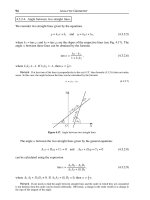Handbook of mathematics for engineers and scienteists part 178 pot
Bạn đang xem bản rút gọn của tài liệu. Xem và tải ngay bản đầy đủ của tài liệu tại đây (378.4 KB, 7 trang )
Chapter T5
Ordinary Differential Equations
T5.1. First-Order Equations
In this Section we shall often use the term “solution” to mean “general solution.”
1. y
x
= f(y).
Autonomous equation.
Solution: x =
dy
f(y)
+ C.
Particular solutions: y = A
k
,wheretheA
k
are roots of the algebraic (transcendental)
equation f(A
k
)=0.
2. y
x
= f(x)g(y).
Separable equation.
Solution:
dy
g(y)
=
f(x) dx + C.
Particular solutions: y = A
k
,wheretheA
k
are roots of the algebraic (transcendental)
equation g(A
k
)=0.
3. g(x)y
x
= f
1
(x)y + f
0
(x).
Linear equation.
Solution:
y = Ce
F
+ e
F
e
–F
f
0
(x)
g(x)
dx,whereF (x)=
f
1
(x)
g(x)
dx.
4. g(x)y
x
= f
1
(x)y + f
0
(x)y
k
.
Bernoulli equation. Here, k is an arbitrary number. For k ≠ 1, the substitution w(x)=y
1–k
leads to a linear equation: g(x)w
x
=(1 – k)f
1
(x)w +(1 – k)f
0
(x).
Solution:
y
1–k
= Ce
F
+(1 – k)e
F
e
–F
f
0
(x)
g(x)
dx,whereF (x)=(1 – k)
f
1
(x)
g(x)
dx.
5. y
x
= f(y/x).
Homogeneous equation. The substitution u(x)=y/x leads to a separable equation: xu
x
=
f(u)–u.
1207
1208 ORDINARY DIFFERENTIAL EQUATIONS
6. y
x
= ay
2
+ bx
n
.
Special Riccati equation, n is an arbitrary number.
1
◦
. Solution for n ≠ –2:
y =–
1
a
w
x
w
, w(x)=
√
x
C
1
J
1
2k
1
k
√
ab x
k
+ C
2
Y
1
2k
1
k
√
ab x
k
,
where k =
1
2
(n + 2); J
m
(z)andY
m
(z) are Bessel functions (see Subsection 18.6).
2
◦
. Solution for n =–2:
y =
λ
x
– x
2aλ
ax
2aλ + 1
x
2aλ
+ C
–1
,
where λ is a root of the quadratic equation aλ
2
+ λ + b = 0.
7. y
x
= y
2
+ f(x)y – a
2
– af(x).
Particular solution: y
0
= a. The general solution can be obtained by formulas given in
Item 1
◦
of equation T5.1.23.
8. y
x
= f(x)y
2
+ ay – ab – b
2
f(x).
Particular solution: y
0
= b. The general solution can be obtained by formulas given in
Item 1
◦
of equation T5.1.23.
9. y
x
= y
2
+ xf(x)y + f (x).
Particular solution: y
0
=–1/x. The general solution can be obtained by formulas given in
Item 1
◦
of equation T5.1.23.
10. y
x
= f(x)y
2
– ax
n
f(x)y + anx
n–1
.
Particular solution: y
0
= ax
n
. The general solution can be obtained by formulas given in
Item 1
◦
of equation T5.1.23.
11. y
x
= f(x)y
2
+ anx
n–1
– a
2
x
2n
f(x).
Particular solution: y
0
= ax
n
. The general solution can be obtained by formulas given in
Item 1
◦
of equation T5.1.23.
12. y
x
=–(n +1)x
n
y
2
+ x
n+1
f(x)y – f (x).
Particular solution: y
0
= x
–n–1
. The general solution can be obtained by formulas given in
Item 1
◦
of equation T5.1.23.
13. xy
x
= f(x)y
2
+ ny + ax
2n
f(x).
Solution: y =
⎧
⎪
⎨
⎪
⎩
√
ax
n
tan
√
a
x
n–1
f(x) dx + C
if a > 0,
|a| x
n
tanh
–
|a|
x
n–1
f(x) dx + C
if a < 0.
T5.1. FIRST-ORDER EQUATIONS 1209
14. xy
x
= x
2n
f(x)y
2
+ [ax
n
f(x) – n]y + bf(x).
The substitution z = x
n
y leads to a separable equation: z
x
= x
n–1
f(x)(z
2
+ az + b).
15. y
x
= f(x)y
2
+ g(x)y – a
2
f(x) – ag(x).
Particular solution: y
0
= a. The general solution can be obtained by formulas given in
Item 1
◦
of equation T5.1.23.
16. y
x
= f(x)y
2
+ g(x)y + anx
n–1
– a
2
x
2n
f(x) – ax
n
g(x).
Particular solution: y
0
= ax
n
. The general solution can be obtained by formulas given in
Item 1
◦
of equation T5.1.23.
17. y
x
= ae
λx
y
2
+ ae
λx
f(x)y + λf (x).
Particular solution: y
0
=–
λ
a
e
–λx
. The general solution can be obtained by formulas given
in Item 1
◦
of equation T5.1.23.
18. y
x
= f(x)y
2
– ae
λx
f(x)y + aλe
λx
.
Particular solution: y
0
= ae
λx
. The general solution can be obtained by formulas given in
Item 1
◦
of equation T5.1.23.
19. y
x
= f(x)y
2
+ aλe
λx
– a
2
e
2λx
f(x).
Particular solution: y
0
= ae
λx
. The general solution can be obtained by formulas given in
Item 1
◦
of equation T5.1.23.
20. y
x
= f(x)y
2
+ λy + ae
2λx
f(x).
Solution: y =
⎧
⎪
⎨
⎪
⎩
√
ae
λx
tan
√
a
e
λx
f(x) dx + C
if a > 0,
|a| e
λx
tanh
–
|a|
e
λx
f(x) dx + C
if a < 0.
21. y
x
= y
2
– f
2
(x) + f
x
(x).
Particular solution: y
0
= f(x). The general solution can be obtained by formulas given in
Item 1
◦
of equation T5.1.23.
22. y
x
= f(x)y
2
– f(x)g(x)y + g
x
(x).
Particular solution: y
0
= g(x). The general solution can be obtained by formulas given in
Item 1
◦
of equation T5.1.23.
23. y
x
= f(x)y
2
+ g(x)y + h(x).
General Riccati equation.
1210 ORDINARY DIFFERENTIAL EQUATIONS
1
◦
. Given a particular solution y
0
= y
0
(x) of the Riccati equation, the general solution can
be written as:
y = y
0
(x)+Φ(x)
C –
Φ(x)f
2
(x) dx
–1
,
where
Φ(x)=exp
2f
2
(x)y
0
(x)+f
1
(x)
dx
.
To the particular solution y
0
(x) there corresponds C = ∞.
2
◦
. The substitution
u(x)=exp
–
f
2
ydx
reduces the general Riccati equation to a second-order linear equation:
f
2
u
xx
–
(f
2
)
x
+ f
1
f
2
u
x
+ f
0
f
2
2
u = 0,
which often may be easier to solve than the original Riccati equation.
3
◦
. For more details about the Riccati equation, see Subsection 12.1.4. Many solvable
equations of this form can be found in the books by Kamke (1977) and Polyanin and
Zaitsev (2003).
24. yy
x
= y + f (x).
Abel equation of the second kind in the canonical form. Many solvable equations of this
form can be found in the books by Zaitsev and Polyanin (1994) and Polyanin and Zaitsev
(2003).
25. yy
x
= f(x)y + g(x).
Abel equation of the second kind. Many solvable equations of this form can be found in the
books by Zaitsev and Polyanin (1994) and Polyanin and Zaitsev (2003).
26. yy
x
= f(x)y
2
+ g(x)y + h(x).
Abel equation of the second kind. Many solvable equations of this form can be found in the
books by Zaitsev and Polyanin (1994) and Polyanin and Zaitsev (2003).
In equations T5.1.27–T5.1.48, the functions
f
,
g
,and
h
are arbitrary composite functions
whose arguments can depend on both
x
and
y
.
27. y
x
= f(ax + by + c).
If b ≠ 0, the substitution u(x)=ax + by + c leads to a separable equation: u
x
= bf (u)+a.
28. y
x
= f(y + ax
n
+ b) – anx
n–1
.
The substitution u = y + ax
n
+ b leads to a separable equation: u
x
= f(u).
29. y
x
=
y
x
f(x
n
y
m
).
Generalized homogeneous equation. The substitution z = x
n
y
m
leads to a separable
equation: xz
x
= nz + mzf (z).
T5.1. FIRST-ORDER EQUATIONS 1211
30. y
x
=–
n
m
y
x
+ y
k
f(x)g(x
n
y
m
).
The substitution z = x
n
y
m
leads to a separable equation: z
x
= mx
n–nk
m
f(x)z
k+m–1
m
g(z).
31. y
x
= f
ax + by + c
αx + βy + γ
.
See Paragraph 12.1.2-3, Item 2
◦
.
32. y
x
= x
n–1
y
1–m
f(ax
n
+ by
m
).
The substitution w = ax
n
+ by
m
leads to a separable equation: w
x
= x
n–1
[an + bmf(w)].
33. [x
n
f(y) + xg(y)]y
x
= h(y).
This is a Bernoulli equation with respect to x = x(y) (see equation T5.1.4).
34. x[f(x
n
y
m
) + mx
k
g(x
n
y
m
)]y
x
= y[h(x
n
y
m
) – nx
k
g(x
n
y
m
)].
The transformation t = x
n
y
m
, z = x
–k
leads to a linear equation with respect to z = z(t):
t[nf(t)+mh(t)]z
t
=–kf(t)z – kmg(t).
35. x[f(x
n
y
m
) + my
k
g(x
n
y
m
)]y
x
= y[h(x
n
y
m
) – ny
k
g(x
n
y
m
)].
The transformation t = x
n
y
m
, z = y
–k
leads to a linear equation with respect to z = z(t):
t[nf(t)+mh(t)]z
t
=–kh(t)z + kng(t).
36. x[sf(x
n
y
m
) – mg(x
k
y
s
)]y
x
= y[ng(x
k
y
s
) – kf(x
n
y
m
)].
The transformation t = x
n
y
m
, w = x
k
y
s
leads to a separable equation: tf(t)w
t
= wg(w).
37. [f(y) + amx
n
y
m–1
]y
x
+ g(x) + anx
n–1
y
m
=0.
Solution:
f(y) dy +
g(x) dx + ax
n
y
m
= C.
38. y
x
= e
–λx
f(e
λx
y).
The substitution u = e
λx
y leads to a separable equation: u
x
= f(u)+λu.
39. y
x
= e
λy
f(e
λy
x).
The substitution u = e
λy
x leads to a separable equation: xu
x
= λu
2
f(u)+u.
40. y
x
= yf(e
αx
y
m
).
The substitution z = e
αx
y
m
leads to a separable equation: z
x
= αz + mzf(z).
41. y
x
=
1
x
f(x
n
e
αy
).
The substitution z = x
n
e
αy
leads to a separable equation: xz
x
= nz + αzf (z).
1212 ORDINARY DIFFERENTIAL EQUATIONS
42. y
x
= f(x)e
λy
+ g(x).
The substitution u=e
–λy
leads to a linear equation: u
x
=–λg(x)u–λf (x).
43. y
x
=–
n
x
+ f(x)g(x
n
e
y
).
The substitution z = x
n
e
y
leads to a separable equation: z
x
= f(x)zg(z).
44. y
x
=–
α
m
y + y
k
f(x)g(e
αx
y
m
).
The substitution z = e
αx
y
m
leads to a separable equation:
z
x
= m exp
α
m
(1 – k)x
f(x)z
k+m–1
m
g(z).
45. y
x
= e
αx–βy
f(ae
αx
+ be
βy
).
The substitution w = ae
αx
+ be
βy
leads to a separable equation: w
x
= e
αx
[aα + bβf (w)].
46. [e
αx
f(y) + aβ]y
x
+ e
βy
g(x) + aα =0.
Solution:
e
–βy
f(y) dy +
e
–αx
g(x) dx – ae
–αx–βy
= C.
47. x[f(x
n
e
αy
) + αyg(x
n
e
αy
)]y
x
= h(x
n
e
αy
) – nyg(x
n
e
αy
).
The substitution t = x
n
e
αy
leads to a linear equation with respect to y = y(t):
t[nf(t)+αh(t)]y
t
=–ng(t)y + h(t).
48. [f(e
αx
y
m
) + mxg(e
αx
y
m
)]y
x
= y[h(e
αx
y
m
) – αxg(e
αx
y
m
)].
The substitution t = e
αx
y
m
leads to a linear equation with respect to x = x(t):
t[αf(t)+mh(t)]x
t
= mg(t)x + f(t).
T5.2. Second-Order Linear Equations
Preliminary remarks. A homogeneous linear equation of the second order has the general
form
f
2
(x)y
xx
+ f
1
(x)y
x
+ f
0
(x)y = 0.(1)
Let y
0
= y
0
(x) be a nontrivial particular solution (y
0
0) of this equation. Then the
general solution of equation (1) can be found from the formula
y = y
0
C
1
+ C
2
e
–F
y
2
0
dx
,whereF =
f
1
f
2
dx.(2)
For specific equations described below, often only particular solutions are given, while
the general solutions can be obtained with formula (2).
T5.2. SECOND-ORDER LINEAR EQUATIONS 1213
T5.2.1. Equations Involving Power Functions
1. y
xx
+ ay =0.
Equation of free oscillations.
Solution: y =
C
1
sinh(x
√
|a| )+C
2
cosh(x
√
|a| )ifa < 0,
C
1
+ C
2
x if a = 0,
C
1
sin(x
√
a )+C
2
cos(x
√
a )ifa > 0.
2. y
xx
– ax
n
y =0.
1
◦
.Forn =–2, this is the Euler equation T5.2.1.12 (the solution is expressed in terms of
elementary function).
2
◦
. Assume 2/(n + 2)=2m + 1,wherem is an integer. Then the solution is
y =
⎧
⎪
⎪
⎨
⎪
⎪
⎩
x(x
1–2q
D)
m+1
C
1
exp
√
a
q
x
q
+ C
2
exp
–
√
a
q
x
q
if m ≥ 0,
(x
1–2q
D)
–m
C
1
exp
√
a
q
x
q
+ C
2
exp
–
√
a
q
x
q
if m < 0,
where D =
d
dx
, q =
n + 2
2
=
1
2m + 1
.
3
◦
.Foranyn, the solution is expressed in terms of Bessel functions and modified Bessel
functions:
y =
⎧
⎪
⎪
⎪
⎨
⎪
⎪
⎪
⎩
C
1
√
xJ
1
2q
√
–a
q
x
q
+ C
2
√
xY
1
2q
√
–a
q
x
q
if a < 0,
C
1
√
xI
1
2q
√
a
q
x
q
+ C
2
√
xK
1
2q
√
a
q
x
q
if a > 0,
where q =
1
2
(n + 2). The functions J
ν
(z), Y
ν
(z)andI
ν
(z), K
ν
(z) are described in Sec-
tions 18.6 and 18.7 in detail; see also equations T5.2.1.13 and T5.2.1.14.
3. y
xx
+ ay
x
+ by =0.
Second-order constant coefficient linear equation. In physics this equation is called an
equation of damped vibrations.
Solution: y =
⎧
⎪
⎨
⎪
⎩
exp
–
1
2
ax
C
1
exp
1
2
λx
+ C
2
exp
–
1
2
λx
if λ
2
= a
2
– 4b > 0,
exp
–
1
2
ax
C
1
sin
1
2
λx
+ C
2
cos
1
2
λx
if λ
2
= 4b – a
2
> 0,
exp
–
1
2
ax
C
1
x + C
2
if a
2
= 4b.
4. y
xx
+ ay
x
+ (bx + c)y =0.
1
◦
. Solution with b ≠ 0:
y =exp
–
1
2
ax
ξ
C
1
J
1/3
2
3
√
bξ
3/2
+ C
2
Y
1/3
2
3
√
bξ
3/2
, ξ = x +
4c – a
2
4b
,
where J
1/3
(z)andY
1/3
(z) are Bessel functions.
2
◦
.Forb = 0, see equation T5.2.1.3.









